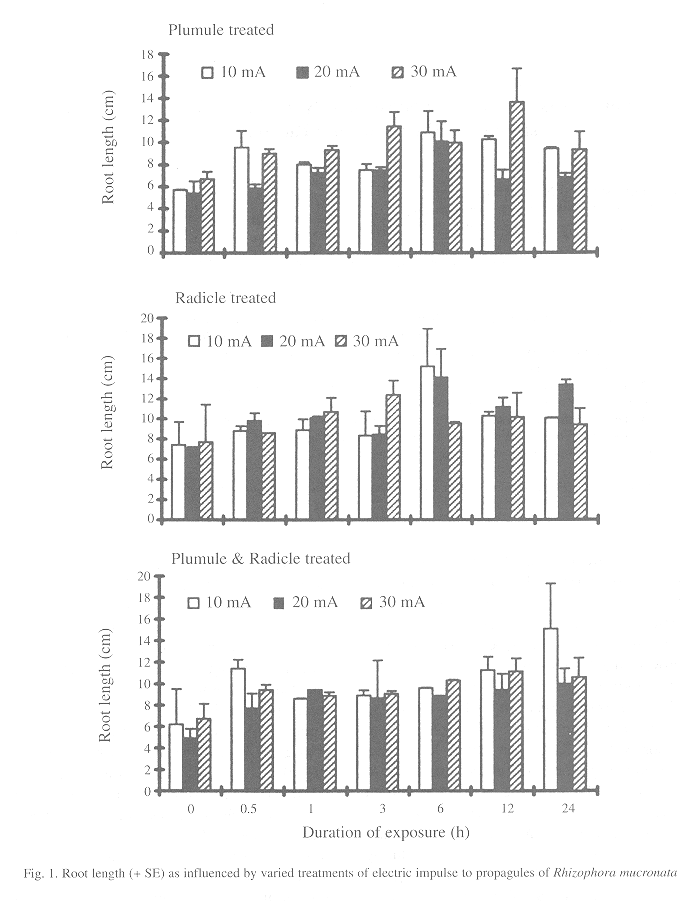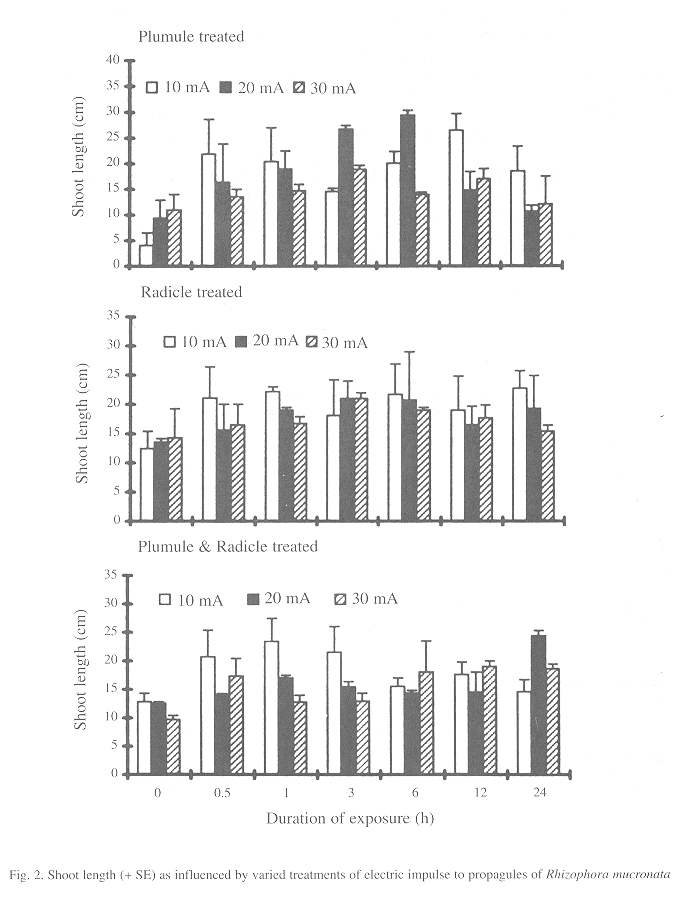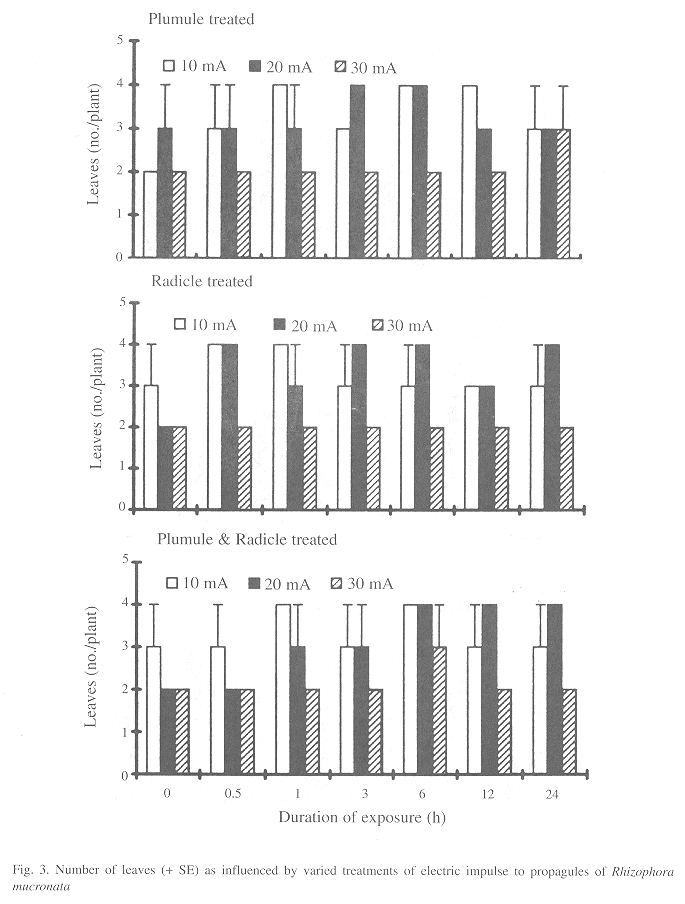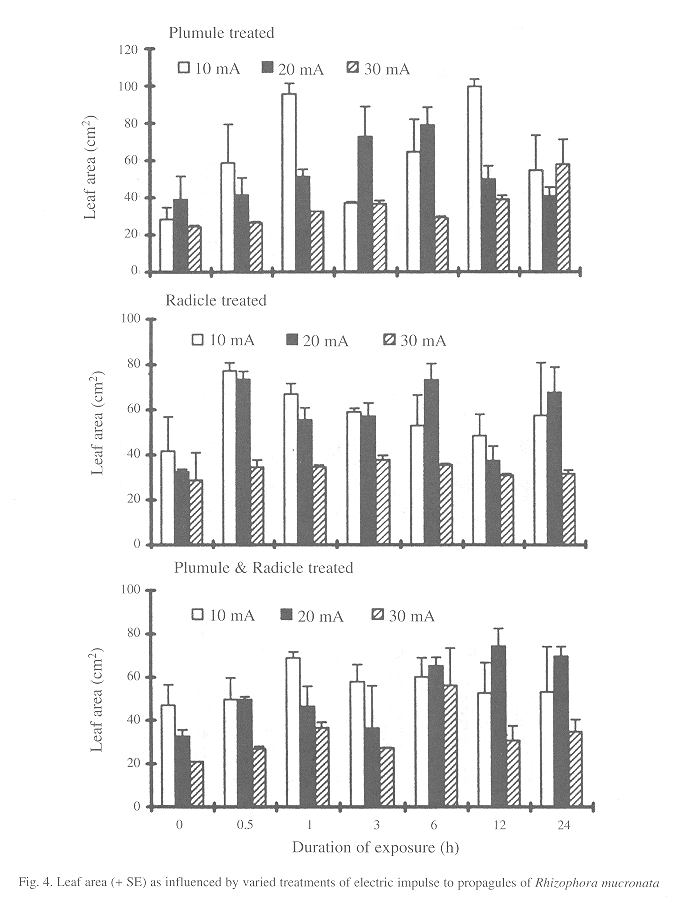Services on Demand
Journal
Article
Indicators
-
 Cited by SciELO
Cited by SciELO -
 Access statistics
Access statistics
Related links
-
 Similars in
SciELO
Similars in
SciELO  uBio
uBio
Share
Revista de Biología Tropical
On-line version ISSN 0034-7744Print version ISSN 0034-7744
Rev. biol. trop vol.48 n.4 San José Dec. 2000
K. Kathiresan and N. Rajendran1
Recibido: 3-XII-99. Corregido: 14-VI-00. Aceptado: 16-VI-00
Abstract
Exposure of mangrove seedlings to electric current was studied at an intensity of 10, 20 and 30 mA to 0.5, 1, 3, 6, 12 and 24 h in different combinations, either to plumule or radicle or both parts of the propagules of Rhizophora mucronata Poir (sample size = 30). The electric current-treated propagules and untreated control were cultured hydroponically in sea water for 75 days, and root and shoot growth parameters measured. The root elongation was significantly influenced by duration of exposure, site of propagule treated and combined effects of current intensity x site of propagule treated. Leaf number and area were significantly influenced by intensity of electric current and duration of exposure; whereas shoot elongation was affected by the duration of exposure. The root number was significantly affected by duration of exposure. In general, the electric impulse improved the growth characteristics of shoot and root.
Key words
Electric impulse, growth, shoot and root elongation, Rhizophora mucronata.
Mangrove seedlings often exhibit poor rooting of propagules resulting in inefficient establishment of seedlings in muddy and loose substratum. Physical treatments are yet to be studied for improving the seedling performance of mangroves. High light intensity has been found to be inhibitory to seedlings of mangroves like Kandelia candel (Fan and Chen 1993)and Rhizophora apiculata (Kathiresan and Moorthy 1993, Kathiresan 1995). To increase the growth performance of the mangrove R. mucronata, the influence of electric current impulses was examined for the first time.
Propagules of Rhizophora mucronata Poir. (28 cm long) were collected during October 1998 from the Pichavaram mangrove forest (11° 27'N; 79° 47'E) at the southeast coast of India. Thirty propagules were kept in 25 l fiber glass tanks containing filtered seawater diluted to a salinity of 15 g. l-1. Water was electrified with DC current from a regulated electric power pack (Elico, India). Three such treated tanks were maintained for 10, 20 and 30 mA, separately. A control tank only with water and propagules was used. In each of the four tanks, 30 propagules were kept in horizontal position in the water to expose both plumule and radicle to the electric current. Five propagules were drawn from each of the four tanks 0.5, 1, 3, 6, 12 and 24 h after electric current input. The experiment was replicated twice with freshly collected propagules. In one experiment, the radicle (basal 13 cm of propagules) was exposed to electricity. In another experiment, the plumule (apical 13 cm of propagules kept in an inverted position) was exposed to electricity. After the treatments, the propagules were transferred to 500 ml containers with 250 ml of 15 g. l-1 filtered and diluted seawater and five propagules were kept per treatment for further studies. The whole treatment and growth experiment was conducted under laboratory conditions with an irradiance of 800 µmol m-2 s-1, at 28 ± 1°C. The growth medium was replenished once every 15 days. After 75 days of the experiment, the seedlings were analysed for number and length of roots, shoot length, number of leaves and area.
The root length was significantly influenced by durations of exposure (T) at varied exposure parts (P) as well as the combinations of Current intensity x Site of exposure of propagules (Fig.1; Table 1).
Shoot length was significantly influenced by the duration of electric treatment (Table 1). The current intensity, site of propagule exposed to treatment, either singly or in combinations did not significantly influence shoot length (Fig. 2; Table 1).
The leaf number was significantly influenced by current intensity. The duration of electric current treatments, site of propagule treated, either singly or in combinations did not significantly influence the leaf number (Fig. 3; Table 1).
Leaf area was significantly influenced by current intensity and duration of exposure and the combinations of Current intensity x Duration of exposure (Fig. 4; Table 1).
In general, the propagule part, (plumule, radicle or both), subjected to the electric impulse did not have a general significant effect, except for root elongation. Although there was no clear cut dose-dependent effect, electric treatment of different durations induced root elongation significantly.
The duration of electric treatment affected root and shoot elongation, and leaf area. Current intensity affected leaf sprouting and leaf area growth. Both current intensity and duration of exposure had a significant effect on leaf area growth (Table 1). In general, shoot length increased with electric treatment of different durations. The electric treatment of 10mA for 12h had a 56.2% increase in shoot length as compared with the control, when the plumule was treated (Fig. 2). The number of leaves increased with current intensity of different durations. However, the number of leaves decreased when a current of high intensity was applied. For instance, the number of leaves ranged from 2 to 4 at 10 mA and from 2 to 3 at 30 mA (Fig. 3). A similar trend was also noted with leaf area: leaf area increased by 251% following treatment of plumule at 10mA for 12h, over the control (Fig. 4). The leaf area was 39 cm2 in 30mA treated seedlings, against 99.5 cm2 in 10mA, plumule-treated ones i.e. a reduction of 60.8% leaf area due to increase in the intensity of electric current (Fig. 4). Although the current intensity had effect on leaf sprouting and leaf area growth, the site of propagule treatment did not have any significant effect on the leaf characteristics (Table 1).
From the aforementioned results, it is inferred that in general the electric current treatments promoted elongation of both shoot and root (Fig. 1,2). The elongation effects in mangroves has been attributed to phytohormone like gibberellins in Rhizophora mangal (Smith et al. 1995) and in Avicennia marina (Kathiresan and Moorthy 1994). A similar elongation effect has been found in the present study in Rhizophora mucronata as result of electric treatments (Fig. 1-4). However, the effects of electric current on gibberellins are not known so far. This aspect has to be studied, besides the probable effect of electric treatments on the cell membrane potential which might affect the growth performance of mangrove seedlings.
Acknowledgements
The authors thank the Director and authorities of Annamalai University for providing facilities and to the Rhode Island Zoological Society, USA for financial support.
References
Fan, H. & J. Chen. 1993. Impacts of light on rooting of mangrove Kandelia candel propagules. J. Guang. Acad. Sci. 9: 73-76. [ Links ]
Kathiresan, K. 1995. Strategies for conservation of a mangrove. J. Annamalai University, part B, 37: 23-32. [ Links ]
Kathiresan, K. & P. Moorthy. 1994. Hormone - induced physiological response of tropical mangrove species. Bot. Mar. 37: 139-141. [ Links ]
Smith, M.S., Y. Yell Yang & Yuji Kamiya. 1995. Environmental controls on the early growth and development of the red mangrove, Rhizophora mangle L.: relationship to endogenous gibberellins. p. 150-160. In M. Ajmal Khan & I.A. Ungar (eds.). Biology of Salt Tolerant Plants. University of Karachi, Karachi. [ Links ]
TABLE 1
Analysis of variance for the growth parameters of Rhizophora mucronata
due to varied treatments of electric impulse
| | | | | |
| Root length | ||||
| Duration of exposure | | | | |
| Site of propagule treated | | | | |
| Current intensity x | ||||
| Site of propagules treated | | | | |
| Error | | | | |
| Shoot length | ||||
| Duration of exposure | | | | |
| Error | | | | |
| Number of leaves | ||||
| Current intensity | | | | |
| Error | | | | |
| Total leaf area | ||||
| Current intensity | | | | |
| Duration of exposure | | | | |
| Current intensity x | ||||
| Duration of exposure | | | | |
| Error | | | |
* - significant P < 0.05
** - significant P < 0.01
1 Centre of Advanced Study in Marine Biology
Annamalai University, Parangipettai 608 502, India


















